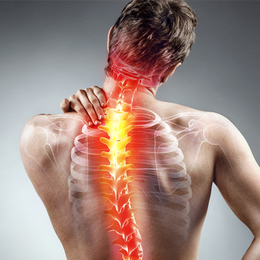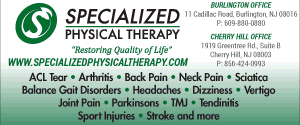
Easing the Suffering
New treatments and therapies are helping those who suffer from back pain find some much-needed relief.
In the United States, back pain remains one of the most common reasons for people to go to the doctor or to miss work. It’s a problem that is far-reaching and often unforgiving. In fact, experts believe that approximately 80 percent of the population will experience back pain at some point in their life.
Fortunately, the number of solutions is also growing.
We spoke to two different experts—a chiropractic expert and a board-certified pain specialist—on the best treatment options to alleviate back pain.
Chiropractic Care
In recent years, physicians have become increasingly more likely to recommend that patients first try chiropractic care for their back pain before moving on to a more invasive treatment if needed. Chiropractic treatment options have come a long way and offer more than just manual manipulation (though that is still an option).
Dr. Michael J. O’Keefe of O’Keefe Chiropractic Center P.A. in Medford says that the implementation of DTS spinal decompression therapy has been a game-changer for many patients. This computer-modulated, traction-based system delivers a painless therapy to achieve relief for those suffering from neck, back and sciatic pain.
“The research shows that utilizing DTS spinal decompression therapy for patients with symptoms associated with disc degeneration and herniation in the cervical and lumbar spine has been a highly effective modality in relieving pain,” O’Keefe says. “But we also augment that type of therapy with other therapeutic applications such as soft tissue applications or even laser therapies. There are a lot of different options for the pain management regimen that we can use to treat patients.”
O’Keefe says that oftentimes, a treatment regimen also incorporates home exercises and overall activity improvement recommendations (sometimes modifications when needed).
“The idea is that once we relieve the pain we also want to get the patient on a path to rehabilitation, which may include some modifications to their daily activities, in order to minimize chronic and recurrent pain syndromes,” O’Keefe adds. “Diet and nutrition can even play a role in all of this. We want to reduce the likelihood of patients sliding back into chronic pain. Chronic pain is debilitating—it impacts daily life. Patients want to be able to have long-term management of their pain so that they can live a normal life.”
Fortunately, the number of solutions is also growing.
We spoke to two different experts—a chiropractic expert and a board-certified pain specialist—on the best treatment options to alleviate back pain.
Chiropractic Care
In recent years, physicians have become increasingly more likely to recommend that patients first try chiropractic care for their back pain before moving on to a more invasive treatment if needed. Chiropractic treatment options have come a long way and offer more than just manual manipulation (though that is still an option).
Dr. Michael J. O’Keefe of O’Keefe Chiropractic Center P.A. in Medford says that the implementation of DTS spinal decompression therapy has been a game-changer for many patients. This computer-modulated, traction-based system delivers a painless therapy to achieve relief for those suffering from neck, back and sciatic pain.
“The research shows that utilizing DTS spinal decompression therapy for patients with symptoms associated with disc degeneration and herniation in the cervical and lumbar spine has been a highly effective modality in relieving pain,” O’Keefe says. “But we also augment that type of therapy with other therapeutic applications such as soft tissue applications or even laser therapies. There are a lot of different options for the pain management regimen that we can use to treat patients.”
O’Keefe says that oftentimes, a treatment regimen also incorporates home exercises and overall activity improvement recommendations (sometimes modifications when needed).
“The idea is that once we relieve the pain we also want to get the patient on a path to rehabilitation, which may include some modifications to their daily activities, in order to minimize chronic and recurrent pain syndromes,” O’Keefe adds. “Diet and nutrition can even play a role in all of this. We want to reduce the likelihood of patients sliding back into chronic pain. Chronic pain is debilitating—it impacts daily life. Patients want to be able to have long-term management of their pain so that they can live a normal life.”
Minimally Invasive Treatment For Spinal Stenosis
Of course, as medicine advances rapidly, so do the surgical options for back pain. Peter G. Pryzbylkowski, M.D., board-certified anesthesiologist and board certified pain specialist from Relievus, which has offices throughout New Jersey and the Philadelphia area, says that the field has come “leaps and bounds with spinal stenosis.” There are currently two new FDA-approved procedures that can help with symptoms of back and leg pain.
The first procedure is minimally invasive lumbar decompression (MILD). Pryzbylkowski recently became one of the first physicians in the area to bring MILD to patients. During this procedure, using an epidural needle, the physician removes excess ligament through a5.1mm portal. This is a same-day procedure with no general anesthesia.
“Afterward, patients are able to stand longer, walk longer and ultimately get back to their lives,” says Pryzbylkowski.
The other procedure is Vertiflex, a minimally invasive stand-alone inter-spinous process decompression (IPD) procedure that involves implanting a device (or “spacer”) between the spinous processes, explains Pryzbylkowski. This holds the vertebrae open, relieving pressure on the nerves in the spinal canal. It is also a same-day procedure with no general anesthesia and only a minimal incision.
“Two or three years ago, the only options for spinal stenosis patients were epidural injections—or being referred out for major spinal surgeries that included three-or four-day hospital stays and a long recovery,” says Pryzbylkowski. “This is a great step for patients who have failed traditional pain management before but had held off on having major surgery. Now, they have another option. Both of these devices have about five years of data behind them and I see the future as very bright. The research and the options will only continue to improve for this patient population.”
Of course, as medicine advances rapidly, so do the surgical options for back pain. Peter G. Pryzbylkowski, M.D., board-certified anesthesiologist and board certified pain specialist from Relievus, which has offices throughout New Jersey and the Philadelphia area, says that the field has come “leaps and bounds with spinal stenosis.” There are currently two new FDA-approved procedures that can help with symptoms of back and leg pain.
The first procedure is minimally invasive lumbar decompression (MILD). Pryzbylkowski recently became one of the first physicians in the area to bring MILD to patients. During this procedure, using an epidural needle, the physician removes excess ligament through a5.1mm portal. This is a same-day procedure with no general anesthesia.
“Afterward, patients are able to stand longer, walk longer and ultimately get back to their lives,” says Pryzbylkowski.
The other procedure is Vertiflex, a minimally invasive stand-alone inter-spinous process decompression (IPD) procedure that involves implanting a device (or “spacer”) between the spinous processes, explains Pryzbylkowski. This holds the vertebrae open, relieving pressure on the nerves in the spinal canal. It is also a same-day procedure with no general anesthesia and only a minimal incision.
“Two or three years ago, the only options for spinal stenosis patients were epidural injections—or being referred out for major spinal surgeries that included three-or four-day hospital stays and a long recovery,” says Pryzbylkowski. “This is a great step for patients who have failed traditional pain management before but had held off on having major surgery. Now, they have another option. Both of these devices have about five years of data behind them and I see the future as very bright. The research and the options will only continue to improve for this patient population.”
To read the digital edition of South Jersey Magazine, click here.
Published (and copyrighted) in South Jersey Magazine, Volume 16, Issue 6 (September 2019).
For more info on South Jersey Magazine, click here.
To subscribe to South Jersey Magazine, click here.
To advertise in South Jersey Magazine, click here.












